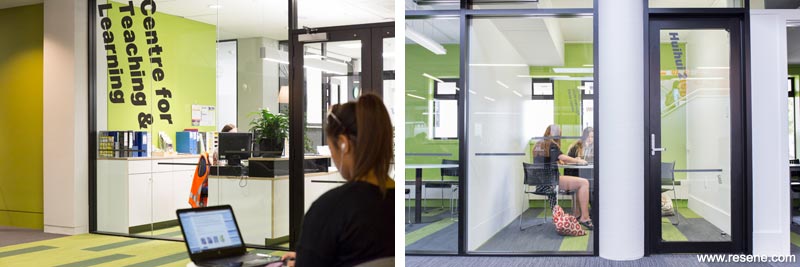Massey University’s Wellington Library
The redevelopment of Massey University’s Wellington Library aims to reinforce the library’s role as the centre of the campus community. The design acknowledges the need to make the library more accessible and open to a wide range of uses and users.

Technology plays a key role through access to the digital collection via WIFI technology, and a focus on info commons as an interactive, flexible, informal learning environment that acts as a transition between the wider campus environment and the library proper, aiming to encourage a wider use of the library facilities. The technology focused spaces are balanced by a range of formal reading and individual and group study spaces with good accessibility to natural light and proximity to the physical collection. The focus of the customer service interface has been to break down the barrier between librarians and students to allow more personalised and specific service to customers.
The structure and character of the existing 1950s building and subsequent additions has been revealed and celebrated in combination with new building elements that act as key way-showing devices to make navigating the library as intuitive as possible without the use of physical signage. This is achieved through the selection of a consistent material palette, a bold colour palette and use of structural elements to order the different spaces within the project.

The library is well located to maximise the exposure to key campus entries and open spaces. Future stages of the project aim to push this further by ‘relaxing’ the boundary of the library and the campus spaces by bringing more parts of the library (info commons, for example) outside of the ‘secure’ line. The design language of the project is developing with strong links to the recently completed Te Ara Hihiko Building, integrating components of extended exhibitions and changing displays within library.

The design concept seeks to extend and challenge the traditional notion of the library as a pataka or storehouse of information and knowledge. This is primarily evidenced in the re-presenting of the library programme to provide a more interactive ‘shopfront’ for the library and is supported by the selection of materials and detailing.
The structure and character of the existing 1950s building has been revealed and celebrated to communicate the story of the existing building. The majority of existing ceilings were removed creating a more generous sense of space, revealing the concrete building structure and layers of previous inhabitation.


The existing structural elements are treated in a consistent neutral finish of Resene Half Foggy Grey (stone grey) and act as the primary spatial ordering elements. This is supported by the layout and treatment of services, which are expressed throughout the building as a further layer of information with primary service runs defining the primary circulation routes. Resene SpaceCote Low Sheen waterborne enamel has been used throughout the project for a durable wall finish.
New elements and finishes serve to contrast the existing ‘raw’ treatment of the building shell. Wall, ceiling and floor finishes are colour-coded to subtly denote more active, collaborative spaces from the more individual and passive spaces without the need for applied behavioural signage. Colours convey an indication of expected activity – stronger colours (Resene Daredevil (fluoro orange), Resene Impromptu (yellow green), Resene Bokara Grey (charcoal black)) relate to more active, noisier areas; cooler more muted colours (Resene Half Foggy Grey, Resene Wan White (umber white), Resene Alabaster (blackened white)) signify less active, quieter areas. The use of Resene Switched On (bright yellow) is used to indicate areas near to where Library or Centre for Teaching & Learning staff are available to respond to your needs. Points of transition to other levels (stairs, lift) are highly visible with their Resene Daredevil walls.


In addition to the use of coding through colour and pattern, consistent minimal way-showing and navigational signage supports the existing and new architecture to make navigating the library as intuitive as possible. Macro and micro levels of way-showing in Resene Bokara Grey allow users to navigate the collection in a flexible manner with subject areas on the range ends and Dewey numbers sitting within the shelves. Four walls have been treated with full height ‘super graphics’. The large graphically shattered letters, realised in Resene Foggy Grey (watery grey), over a background of Resene Bokara Grey and Resene Daredevil, spell out the words ’LIBRARY’, ‘DISCIPLINE’, ‘ORDER’ and ‘QUIET’ offering a few provocations on the nature of the Library and the pursuit of knowledge. They signal a disruption of the traditional concept of a library as a very quiet and ordered space, one where disciplines of knowledge were neatly stored.

The Massey University Wellington Library Redevelopment won the Resene Total Colour Education Senior Colour Maestro Award. The judges thought “This building is revealed and celebrated with the use of colour, layout and treatment. Colour is used to give the eye a grip on shape and provides a navigational coding device. Touches of colour are used with care to energise but not overpower the learning environment.
The palette conveys an indication of expected activity and makes points of transition to other levels highly visible. It’s fresh, modern and motivating.”
Architectural specifier: Athfield Architects Ltd
Building contractor: Arrow International
Client: Massey University Wellington
Photographer: Simon Devitt, Oliver Ward
Wayfinding and Environmental Graphics: SV Associates
Winner: Resene Total Colour Education Senior Colour Maestro Award
Project: Resene Total Colour Awards 2015
From the Resene News – issue 4/2015
Resene case studies/awards project gallery
View case studies that have used Resene products including many from our Resene Total Colour Awards. We hope these projects provide inspiration for decorating projects of your own... view projects
Total Colour Award winners:
2023 |
2022 |
2021 |
2020 |
2019 |
2018 |
2017 |
2016 |
2015 |
2014 |
2013 |
2012 |
2011 |
2010 |
Entry info
Latest projects | Project archive | Resene news archive | Colour chart archive